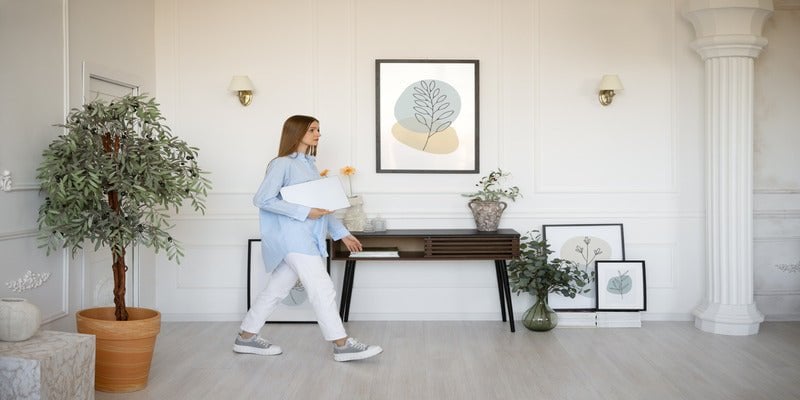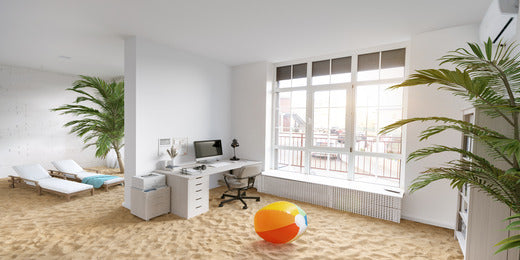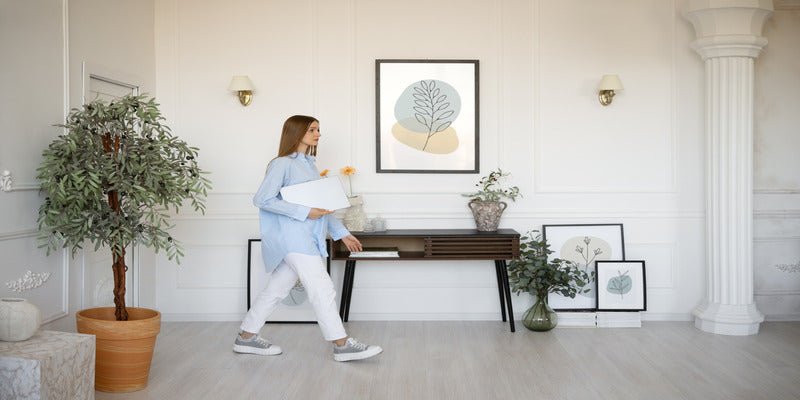Purify Your Space: A Guide on How Can You Improve Indoor Air Quality

In the hustle and bustle of our daily lives, we often overlook a critical factor that profoundly impacts our well-being: the air we breathe indoors. Indoor air quality (IAQ) is an essential aspect of our overall health, yet it frequently remains unnoticed until it becomes a problem. The quality of the air we inhale within the confines of our homes, workplaces, and other indoor spaces can significantly influence our health and comfort.
The impact of poor indoor air quality on our health should not be underestimated. Various air pollutants, some of which are invisible to the naked eye, can lurk in our living spaces, quietly compromising our respiratory health and overall vitality. Particulate matter, allergens like pollen and pet dander, volatile organic compounds (VOCs), bacteria, and viruses are among the invisible culprits that can infiltrate our indoor environments, leading to a range of health issues such as allergies, respiratory problems, and even more severe illnesses.
In this comprehensive guide, we will delve into the world of indoor air quality and air purifiers, exploring how the quality of our indoor air can impact our lives and how air purifiers can play a pivotal role in mitigating these concerns. By the time you finish reading, you will have a clear understanding of how air purifiers can transform your living space into a sanctuary of clean, fresh air, fostering better health and well-being for you and your loved ones.
Understanding Indoor Air Quality
Indoor air quality, often abbreviated as IAQ, refers to the condition of the air within buildings and other enclosed spaces, including homes, offices, schools, and public facilities. It encompasses the presence and concentration of various pollutants and contaminants in the indoor air, which can have direct and indirect effects on the health, comfort, and well-being of the occupants.
Common indoor air pollutants:
- Particulate matter (PM): Particulate matter consists of tiny, airborne particles and droplets that can vary in size. Common sources include dust, smoke, pollen, and fine particles from combustion processes. PM can be inhaled deep into the lungs and may lead to respiratory issues and exacerbate pre-existing conditions.
- Allergens (pollen, dust mites, pet dander): Allergens are substances that trigger allergic reactions in susceptible individuals. Pollen from plants, dust mites found in bedding and upholstery, and pet dander from animals are common indoor allergens. Exposure to these allergens can result in allergies, asthma symptoms, and other respiratory problems.
- Volatile Organic Compounds (VOCs): VOCs are organic chemicals that can easily vaporize into the air. They originate from various sources, including household products like paints, cleaning agents, and furniture, as well as building materials. Prolonged exposure to VOCs can lead to headaches, eye and throat irritation, and more severe health issues in some cases.
- Bacteria and viruses: Microorganisms such as bacteria and viruses can circulate in indoor air and pose health risks to occupants. Contaminated air can lead to the spread of illnesses, including colds, flu, and respiratory infections.
Health effects of poor indoor air quality:
Poor indoor air quality can have a profound impact on human health, causing or exacerbating a range of physical and respiratory ailments. Some common health effects of outdoor air pollution include:
- Respiratory problems: Exposure to indoor pollutants like PM and allergens can lead to coughing, wheezing, shortness of breath, and aggravate conditions like asthma and bronchitis.
- Allergic reactions: Allergens in the air can trigger allergic responses, including sneezing, runny nose, itchy eyes, and skin rashes.
- Headaches and fatigue: High levels of VOCs and other indoor pollutants can cause symptoms such as headaches, dizziness, and fatigue.
- Infections: Airborne bacteria and viruses can spread illnesses, especially in enclosed spaces with poor ventilation.
- Long-term health risks: Chronic exposure to poor indoor air quality can increase the risk of developing more severe health conditions, including heart disease, respiratory diseases, and certain cancers.
Understanding these common indoor air pollutants and their potential health effects underscores the importance of maintaining good indoor air quality. It also highlights the vital role that air purifiers can play in reducing the concentration of these contaminants and improving the air we breathe in our indoor environments.

How Air Purifiers Work?
Air purifiers are devices designed to improve indoor air quality by removing airborne pollutants and contaminants. These devices consist of various components that work together to capture or neutralize particles and gases present in the air.
Key components of air purifiers include:
- Filters: Air purifiers typically employ one or more types of filters to trap particles. Common filter types include HEPA filters, activated carbon filters, and pre-filters.
- Fan or Blower: Air purifiers use a fan or blower to circulate air through the filters, ensuring that a continuous flow of air is cleaned.
- UV-C Light (in some models): Ultraviolet germicidal irradiation is used in certain air purifiers to kill or inactivate microorganisms like bacteria and viruses.
- Ionic and Electrostatic Technologies (in some models): These technologies release charged particles into the air to attract and remove airborne particles, but they are less common than filter-based purifiers.
Types of air purifiers:
- High-Efficiency Particulate Air (HEPA) filters: HEPA filters are highly effective at capturing particles as small as 0.3 microns, including dust, pollen, pet dander, and some bacteria. They are the gold standard for particle removal.
- Activated carbon filters: Activated carbon filters are excellent at adsorbing odors, gases, and volatile organic compounds (VOCs) from the air. They are often used alongside HEPA filters to provide comprehensive air purification.
- Ultraviolet (UV) germicidal irradiation: UV-C light purifiers use ultraviolet light to kill or inactivate microorganisms like bacteria and viruses. They can be effective for reducing the risk of airborne diseases.
- Ionic and electrostatic purifiers: These purifiers release charged ions or use an electrostatic charge to attract and collect particles, including allergens and some viruses. However, they may produce ozone as a byproduct, which can be a concern.
Choosing the right air purifier for your needs:
Selecting the right air purifier depends on your specific indoor air quality concerns and room size. Consider the following factors when choosing an air purifier:
- Room size: Choose a purifier with a Clean Air Delivery Rate (CADR) suitable for the size of the room you want to purify.
- Specific concerns: Identify the types of pollutants you want to target. For allergens, a HEPA filter is essential. For odors and VOCs, consider a purifier with an activated carbon filter.
- Noise level: Different purifiers have varying noise levels. If you plan to place the purifier in a bedroom or quiet area, opt for a quieter model.
- Maintenance: Check the filter replacement schedule and ease of maintenance. Some purifiers have washable filters, while others require regular replacements.

Benefits of Using Air Purifiers
- Improved respiratory health: Air purifiers can remove airborne particles harmful chemicals that trigger respiratory issues, leading to improved lung function and reduced symptoms.
- Allergy and asthma symptom reduction: By capturing allergens like pollen and pet dander, air purifiers can alleviate allergy and asthma symptoms, allowing for easier breathing.
- Reduction in airborne diseases: UV-C purifiers and air filters can help reduce the spread of airborne viruses and bacteria, contributing to a healthier environment.
- Odor and chemical removal: Activated carbon monoxide filters effectively remove odors and VOCs, creating a more pleasant and breathable indoor space.
- Enhanced sleep from unhealthy indoor air quality: Cleaner air can lead to better sleep by reducing nighttime allergies and improving overall comfort.
- Increased overall well-being: Breathing clean air can have a positive impact on your overall health and well-being, helping you feel more energized and focused throughout the day.
How to Maximize Air Purifier Effectiveness?
Air purifiers can significantly improve indoor air quality when used correctly. To ensure you get the most out of your air purifier and enjoy the benefits of cleaner air, consider the following strategies to improve your indoor air well:
Proper placement of air purifiers:
The placement of your air purifier is crucial for its effectiveness. Here's how to position it optimally:
- Central Location: Place the air purifier in a central location within the room. This allows it to circulate and filter air more efficiently.
- Avoid Obstructions: Ensure that the purifier has adequate space around it, and there are no obstructions like furniture or curtains blocking the intake or exhaust vents.
- Elevated Placement: If possible, place the air purifier at a higher level (e.g., on a table or shelf) to capture and clean a broader range of air.
- Multiple Units: For larger spaces, consider using multiple air purifiers strategically placed throughout the area for comprehensive coverage.
Maintenance and filter replacement:
Regular maintenance is essential to keep your air purifier running at its best:
- Clean the Pre-filter: If your purifier has a pre-filter, clean or replace it as recommended by the manufacturer. This pre-filter captures larger particles and helps extend the life of the main filter.
- Replace Filters: Follow the manufacturer's guidelines for filter replacement. HEPA filters, carbon filters, and other filters have a limited lifespan, and replacing them on schedule ensures continued effectiveness.
- Clean the Unit: Periodically clean the exterior and interior of the air purifier to prevent the accumulation of dust and debris.
Sizing the air purifier for your space:
Choosing the right-sized air purifier is crucial for effective air purification:
- Calculate Room Size: Measure the square footage of the room where you'll be using the purifier. Most air purifiers provide a recommended room size in their specifications.
- Match CADR: Look for a purifier with a Clean Air Delivery Rate (CADR) that matches or exceeds the size of your room. A higher CADR is more effective in larger spaces.
- Consider ACH: Air Changes Per Hour (ACH) is another important factor. For allergy sufferers, aim for at least 4 ACH. Calculate it by dividing the purifier's CADR by the room's volume.
Using additional ventilation strategies:
To further enhance the effectiveness of your air purifier, consider these ventilation strategies:
- Open Windows: When outdoor air quality is good, periodically open windows to allow fresh air to circulate and dilute indoor pollutants.
- Use Exhaust Fans: Use exhaust fans in bathrooms and the kitchen to expel indoor pollutants and moisture.
- Air Circulation: Use ceiling fans or standalone fans to help distribute purified air evenly throughout the room.
- Maintain Ideal Humidity: Keep indoor humidity levels between 30% and 50% to discourage the growth of mold and dust mites.
- Reduce Indoor Pollutant Sources: Minimize indoor sources of pollution, such as smoking, using harsh chemicals, or burning candles, to reduce the workload on your air purifier.
By following these guidelines for proper placement, regular maintenance, appropriate sizing, and complementary ventilation strategies, you can maximize the effectiveness of your air purifier and enjoy cleaner, healthier indoor air.

Other Strategies for Improving Indoor Air Quality
Keeping your home clean and dust-free is essential for maintaining good indoor air quality. Regular cleaning and dusting can help reduce the accumulation of dust, allergens, and particulate matter that can circulate in the air. Pay attention to frequently overlooked areas like vents, fans, and carpets.
Managing humidity levels:
Maintaining the right indoor humidity level is crucial. Too much air conditioning, too much humidity can promote mold and dust mite growth, while overly dry air can exacerbate respiratory issues. Use a dehumidifier or humidifier as needed to keep indoor humidity between 30% and 50%.
Eliminating or reducing indoor pollution sources:
Identify and address sources of indoor air pollution to prevent contaminants from entering your living space. Some steps you can take include:
- Proper Ventilation: Ensure good ventilation when cooking, using chemicals, or smoking indoors. Use exhaust fans to remove pollutants.
- Switch to Eco-Friendly Products: Use environmentally friendly and low-VOC (volatile organic compound) cleaning products and paints to reduce chemical emissions.
- Limit Smoking: If anyone smokes indoors, encourage them to do so outside. Smoking indoors significantly degrades air quality.
Using natural air purifiers (houseplants):
Certain houseplants can help improve indoor air quality by absorbing pollutants and releasing oxygen. While they shouldn't be relied upon as the sole air purifiers, incorporating indoor plants can reduce indoor air pollutants and be a beneficial addition to your overall air quality improvement strategy. Some effective air-purifying plants include snake plants, spider plants, and peace lilies. Just be mindful not to overwater them, as excessive moisture can lead to mold growth.

Conclusion
In the quest for a healthier air cleaner and more comfortable living environment, the importance of indoor air quality cannot be overstated. Our homes and indoor spaces should be sanctuaries of clean, fresh air, where we can breathe easy and thrive.
Throughout this guide, we've explored the significance of indoor air quality and the potential health impacts of poor indoor air pollution and quality. We've delved into the inner workings of air purifiers, shedding light on their various technologies and capabilities, and we've discussed how to choose the right purifier for your needs.
We've also highlighted the multitude of benefits that air purifiers bring to our lives, from improved respiratory health to allergy relief and even better sleep quality.
But remember, air purifiers are just one piece of the puzzle. To truly purify your space and achieve optimal indoor air quality, it's essential to adopt a holistic approach. Regular maintenance, proper ventilation, air conditioning systems and the reduction of indoor pollution sources are equally crucial components of the equation.





































-1.jpg?height=200&name=photo_2023-11-30_19-30-22%20(1)-1.jpg)

